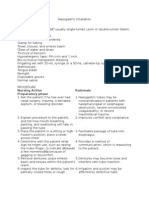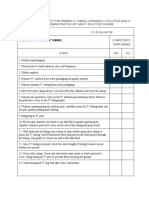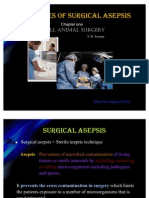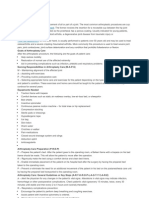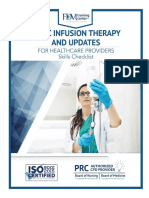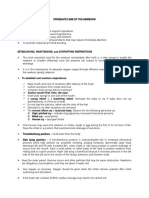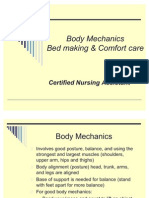Catheter Care Plan
Catheter Care Plan
Uploaded by
Dilsha GurugeCopyright:
Available Formats
Catheter Care Plan
Catheter Care Plan
Uploaded by
Dilsha GurugeCopyright
Available Formats
Share this document
Did you find this document useful?
Is this content inappropriate?
Copyright:
Available Formats
Catheter Care Plan
Catheter Care Plan
Uploaded by
Dilsha GurugeCopyright:
Available Formats
Date:
My Catheter Care Plan
Patient Name:
Date of birth: NHS number:
Reason for catheter:
This care plan has been designed to provide you with advice on how to look after your catheter. If you have
any appointments at your GP practice, at the hospital, or if you have an in-patient stay at a hospital, be sure
you take this care plan with you. This is to make sure that everyone looking after your catheter is aware of
your care, including any action that has been taken and is due to take place.
What is a urinary catheter?
A catheter is a thin, hollow tube that drains urine from the bladder into a drainage bag; it can be
inserted on a long term or a temporary basis.
If a catheter remains in the bladder it is known as an indwelling catheter.
How do I look after my catheter?
Empty your catheter bag when it is two thirds full of urine.
If you have a valve attached to your catheter instead of a leg bag open the valve when:
o You feel your bladder is full
o Before you go to bed
o On waking
o During the night, if necessary
o Every 3-4 hours during the day
o Before opening your bowels.
Replace the leg bag and/or valve once a week.
Only disconnect the leg bag or valve weekly when it is replaced with a new bag/valve.
Attach a NEW night bag to the leg bag or valve every night.
Remove the night bag every morning, close the leg bag tap and/or catheter valve and dispose of the
night bag.
What do I do if I am in pain or discomfort?
When a catheter has first been inserted it is normal to feel some lower abdominal (tummy) pain.
If the pain continues contact your Community Nurse.
How often will the catheter need changing?
Between 4 -12 weeks depending on the type of material your catheter is made from.
This information will be written in the back of this booklet.
What should my urine look like?
Your urine should be a light yellow colour but is largely dependent on the amount you drink.
Remember that you should be aiming to drink around 1½- 2 litres of fluid a day, or 8 mugs.
If your urine is cloudy and does not improve after drinking more, always contact your Community
Nurse or GP.
February 2019 Page 1 of 5
How do I help prevent infection?
The most common complication associated with a catheter is infection. Taking the following steps will
reduce this risk:
1.Always wash your hands before and after touching your catheter.
2.Always make sure that the area around the insertion area is clean. You can do this by washing it with
mild soap and water at least twice a day.
3.Women need to make sure that the genital area is washed from front to back. This will prevent
spreading any infection from your back passage on to the actual catheter.
4.Men should carefully wash under the foreskin (unless you have been circumcised). Remember to
replace the foreskin over the end of the penis after drying.
5.To prevent irritation, it is best to avoid talc, antiseptic, bubble bath or bath salts and creams.
6.When you have a bath or shower do not remove your leg bag, if you are using one.
7.Always ensure that if your care giver is changing your catheter drainage bag or valve, he/she is
wearing gloves.
What do I do if my catheter is not draining or is leaking?
Check that the drainage bag is below the level of the bladder, particularly when sitting in a low chair.
Make sure that the catheter tubing is not kinked.
Make sure that the drainage bag is connected properly. The urine will not drain into the bag if it is full.
Empty the bag when it is two thirds full.
If possible try and walk around and change position.
Constipation can prevent the catheter from draining.
If you do experience urine leakage, contact your Community Nurse.
How do I dispose of used catheter bags?
Empty the contents into the toilet.
Double wrap the bag (either in newspaper or a plastic bag).
Place in your household waste bin then wash your hands
Can I have sex?
Having sexual intercourse with an indwelling urethral catheter in place is not recommended as there is
potential for infection, discomfort and possible trauma.
For those with an active sex life it is recommended that discussions take place with your GP and/or
Specialist about other forms of catheterisation.
For example:
Suprapubic - this is an indwelling urinary catheter inserted via a small hole in the lower abdomen
(tummy) or
Intermittent catheterisation - this is when a catheter is inserted periodically throughout the day to empty
the bladder. It only remains in the bladder until urine has finished draining then it is removed.
When should I ask for help?
Your catheter should always be comfortable and should not cause you any pain. Always ask for help if you
experience any of the following:
If you experience sharp, intense lower stomach pain.
If the urine is not draining and you have already followed the guidance in this booklet.
If your catheter falls out and you are unable to pass urine.
If your urine is smelly, cloudy or if you have a burning sensation, which does not get better after
drinking more fluids.
If urine is leaking around your catheter and making your clothing wet.
There is blood in your urine.
February 2019 Page 2 of 5
Best Practice Guidelines for Staff
Catheterisation
Catheterisation should only be carried out by an appropriately trained person.
Aseptic technique should be used.
The meatus should be cleaned with saline before insertion of the catheter.
A single use local anaesthetic lubricant should be used.
Monitor drainage of urine, colour of urine, signs of debris in urine.
When recatheterising the patient observe the tip of the removed catheter and look for signs of
encrustation. If this is present the frequency of catheter changes may need to be reviewed and
advice sought from the Specialist Teams (i.e. Continence Team WHHT or Bladder and Bowel Team
HCT) on catheter maintenance solutions.
Catheters should be changed according to manufacturer’s recommendations.
Catheter size, balloon volume, batch number and expiry date should be documented in this catheter
passport and nursing care notes.
Urine samples must be obtained from the needle-free sampling port using a non-touch technique.
Catheter Care
Wash hands & use non-sterile gloves before handling catheter or drainage bag and wash hands
afterwards.
Daily hygiene care of genital area.
A leg bag should be worn during the day and secured with straps or catheter bag leg sleeve.
A link system should be used at night by adding a night bag to the leg bag or catheter bag leg sleeve.
Drainage bags should be positioned below the level of the bladder and should not be in contact with
the floor.
Night drainage bags must be supported by a stand.
Remember the following
To check if the patient has any moisture lesions.
To check the patient for any indication of a pressure ulcer/s.
To prevent falls check any loose bags/stands etc.
MRSA
If the patient has a history of MRSA in their appropriate guidance should be followed and antibiotics should
be given 30 minutes prior to catheterisation or recatheterisation.
If during insertion or removal of the catheter there is a possibility of trauma to the urethra or if bleeding
occurs please call for a medical review urgently and gentamicin should be considered.
Date of positive result for MRSA in the urine:
Date gentamicin given prophylactic prior to insertion/change of catheter:
NB Patients with MRSA in other sites, for example nose, wounds, do not need antibiotic cover but will need
to be monitored for signs and symptoms of infection.
February 2019 Page 3 of 5
Catheter Record
GP Details
Name: Telephone:
Address:
Community Nurse
Name: Telephone:
Address:
Clinic/Hospital
Name: Telephone:
Address:
First Catheter Insertion
Date:
Catheter: Type: Size:
Batch no: Expiry Date:
Reason for insertion:
Where insertion took place:
Future plans:
Name of Hospital Consultant:
Date of next planned change:
Name of professional:
Signature:
Catheter Change
Date:
Catheter: Type: Size:
Batch no: Expiry Date:
Reason for catheter change:
Any problems:
Date of next planned change:
Name of professional:
Signature:
February 2019 Page 4 of 5
Catheter Change
Date:
Catheter: Type: Size:
Batch no: Expiry Date:
Reason for catheter change:
Any problems:
Date of next planned change:
Name of professional:
Signature:
Catheter Change
Date:
Catheter: Type: Size:
Batch no: Expiry Date:
Reason for catheter change:
Any problems:
Date of next planned change:
Name of professional:
Signature:
Catheter Change
Date:
Catheter: Type: Size:
Batch no: Expiry Date:
Reason for catheter change:
Any problems:
Date of next planned change:
Name of professional:
Signature:
Catheter Removal
Date:
Reason for catheter removal:
Any problems:
Any follow-up:
Name of professional:
Signature:
February 2019 Page 5 of 5
You might also like
- Save You by Mona KastenDocument266 pagesSave You by Mona KastenTereza Jarešová100% (1)
- Glamour WalkthroughDocument31 pagesGlamour WalkthroughNeil Rex100% (1)
- Chapter 24 Management of Patients With Structural, Infectious, and Inflammatory Cardiac DisordersDocument41 pagesChapter 24 Management of Patients With Structural, Infectious, and Inflammatory Cardiac Disordersسلطان محمد فوزي سلمانNo ratings yet
- Urinary Catheter Core Care Plan September 2015 PDFDocument2 pagesUrinary Catheter Core Care Plan September 2015 PDFAsh Staley Delvin Spark100% (1)
- Constipation and Bladder and Bowel Control - Oct 2013Document4 pagesConstipation and Bladder and Bowel Control - Oct 2013Dr.Kamlesh BariNo ratings yet
- Falls Prevention Program Ipsg: Ahmad ThaninDocument12 pagesFalls Prevention Program Ipsg: Ahmad Thaninmanoj reddyNo ratings yet
- TrendCare User GuidelinesDocument11 pagesTrendCare User GuidelinesRidha SyahputraNo ratings yet
- Restraint CompetencyDocument6 pagesRestraint CompetencyFrederick RyanNo ratings yet
- Career CNA PDFDocument2 pagesCareer CNA PDFdgina8800No ratings yet
- CatheterizationDocument32 pagesCatheterizationJohn Dave V. VillarmenteNo ratings yet
- Wound Drain Tube Management v2Document17 pagesWound Drain Tube Management v2Priya100% (1)
- Group 3-DIALYSISDocument62 pagesGroup 3-DIALYSISFesto HakiNo ratings yet
- 2012 Stoma and Wound Training PROGRAM - SPMCDocument2 pages2012 Stoma and Wound Training PROGRAM - SPMCHarby Ongbay AbellanosaNo ratings yet
- Mechanical Ventilation For NursingDocument65 pagesMechanical Ventilation For Nursingsasmita nayakNo ratings yet
- Nursing Action Rationale Preparatory PhaseDocument6 pagesNursing Action Rationale Preparatory Phasemarie100% (2)
- Push 3Document2 pagesPush 3Sandeep SharmaNo ratings yet
- Drug Calculations For NursesDocument4 pagesDrug Calculations For NursesynottripNo ratings yet
- Nursing Cares For Hemodialysis Patient: Hemodialysis Vascular Access: Assess TheDocument34 pagesNursing Cares For Hemodialysis Patient: Hemodialysis Vascular Access: Assess TheEDz Delica SandovalNo ratings yet
- Vascular Disorder Case StudyDocument3 pagesVascular Disorder Case StudyAaron Wallace100% (1)
- 15Document21 pages15Tyson Easo JonesNo ratings yet
- Naso Orogastric Tube Guideline For The Care of Neonate Child or Young Person RequiringDocument12 pagesNaso Orogastric Tube Guideline For The Care of Neonate Child or Young Person RequiringmeisygraniaNo ratings yet
- PROCEDURE CHECKLIST FOR PRIMING IV TUBING AND ETC Revised 1Document3 pagesPROCEDURE CHECKLIST FOR PRIMING IV TUBING AND ETC Revised 1Nicole Sherry M. CHEENo ratings yet
- Leaping the Hurdles: The Essential Companion Guide for International Medical Graduates on their Australian JourneyFrom EverandLeaping the Hurdles: The Essential Companion Guide for International Medical Graduates on their Australian JourneyNo ratings yet
- Appendix H-Care of The Patient With A Hemodialysis CatheterDocument2 pagesAppendix H-Care of The Patient With A Hemodialysis CatheterKavidu KeshanNo ratings yet
- Central VenousDocument1 pageCentral VenousAlexandra DtcNo ratings yet
- Providing Catheter CareDocument2 pagesProviding Catheter CareMarcia Almeida100% (1)
- KON HandbookDocument78 pagesKON HandbookRasyad KamalNo ratings yet
- Magnet Committee CharterDocument2 pagesMagnet Committee Charterapi-543981402No ratings yet
- Principles of Surgical AsepsisDocument54 pagesPrinciples of Surgical AsepsisDddd3rdNo ratings yet
- Emergency Drugs (LEAD)Document8 pagesEmergency Drugs (LEAD)RayePrudenteNo ratings yet
- Maternity Nursing Part 1Document12 pagesMaternity Nursing Part 1danica_2956No ratings yet
- SuctioningDocument12 pagesSuctioningHannah Clarissa Faith AguilarNo ratings yet
- Tracheostomy SlidesDocument24 pagesTracheostomy SlidesMohammed AdamNo ratings yet
- 07 Crash Cart Medication - (App-Pha-007-V2)Document4 pages07 Crash Cart Medication - (App-Pha-007-V2)سلمىNo ratings yet
- Nursing Skills ChecklistDocument6 pagesNursing Skills Checklistapi-433883631No ratings yet
- IV TherapyDocument65 pagesIV TherapySarah Uy CaronanNo ratings yet
- Explanation and Consent: Intravenous CannulationDocument3 pagesExplanation and Consent: Intravenous CannulationAyu IsmaNo ratings yet
- TPN, CVP, Mech Vent, Dialysis SKILLS LABDocument14 pagesTPN, CVP, Mech Vent, Dialysis SKILLS LABmelba040510No ratings yet
- Aseptic Technique: Technical Skills Core CurriculumDocument44 pagesAseptic Technique: Technical Skills Core CurriculumAbby GailNo ratings yet
- Administering Pulse OxDocument2 pagesAdministering Pulse OxjepoiNo ratings yet
- Continuous Bladder IrrigationDocument13 pagesContinuous Bladder IrrigationMichelle Migrino PachoNo ratings yet
- Trends and Issues of Nursing EducationDocument10 pagesTrends and Issues of Nursing EducationYen-yen FaveNo ratings yet
- Colostomy ChecklistDocument1 pageColostomy ChecklistLyssa Marie EgeNo ratings yet
- Emergency Rooms (ER) : Presented By: AdamDocument6 pagesEmergency Rooms (ER) : Presented By: AdamSulemanNo ratings yet
- Code of Ethics For NursesDocument5 pagesCode of Ethics For NursesAmina Abba HaliruNo ratings yet
- Arthroplasty CareDocument3 pagesArthroplasty CareEmjhay Swakida100% (1)
- Bullets For Nursing Basic Concepts Part 15Document61 pagesBullets For Nursing Basic Concepts Part 15oh_chamieNo ratings yet
- Urinary CalculiDocument2 pagesUrinary CalculiJayceeniPatricia CoronelNo ratings yet
- Professional Portfolio NFDN 2003Document2 pagesProfessional Portfolio NFDN 2003api-319266253No ratings yet
- Appendix 7. Tracheostomy Care Bundle Jan 2018Document1 pageAppendix 7. Tracheostomy Care Bundle Jan 2018Yoga DSNo ratings yet
- Et TubeDocument31 pagesEt Tubeinno so qtNo ratings yet
- FIVI Skills ChecklistsDocument14 pagesFIVI Skills ChecklistsMargaux CayanaNo ratings yet
- Newborn Care 101 2nd SemDocument18 pagesNewborn Care 101 2nd SemFilamae Jayahr CadayNo ratings yet
- GastrostomyDocument16 pagesGastrostomyhengkihanggaraNo ratings yet
- Operating RoomDocument13 pagesOperating RoomJessica Pacris Maramag100% (1)
- Closed GlovingDocument2 pagesClosed GlovingMary Ann SacramentoNo ratings yet
- Procedure Checklist Chapter 27: Collecting A Clean-Catch Urine SpecimenDocument2 pagesProcedure Checklist Chapter 27: Collecting A Clean-Catch Urine SpecimenjthsNo ratings yet
- CNA Body Mechanics Bed Making Comfort CareDocument32 pagesCNA Body Mechanics Bed Making Comfort CareFaith VaughnNo ratings yet
- TB QuestionnaireDocument1 pageTB QuestionnaireaplesgjskNo ratings yet
- RETDEM - Wearing of Appropriate PPEsDocument4 pagesRETDEM - Wearing of Appropriate PPEsYo MamaNo ratings yet
- NURSING EMERGENCIES. 10 BASED TEST QUESTIONS WITH BIBLIOGRAPHYFrom EverandNURSING EMERGENCIES. 10 BASED TEST QUESTIONS WITH BIBLIOGRAPHYNo ratings yet
- Hand Dryers Vs Paper Towels Presentation 1Document13 pagesHand Dryers Vs Paper Towels Presentation 1kirstybumzNo ratings yet
- 7500 Beech AvenueDocument13 pages7500 Beech AvenueChristine SparksNo ratings yet
- Housekeeping NC Ii: Lo1: Provide Housekeeping Services To GuestsDocument3 pagesHousekeeping NC Ii: Lo1: Provide Housekeeping Services To GuestsMary Jane Ocampo100% (1)
- Jobaid-W10329932-L-84 2Document84 pagesJobaid-W10329932-L-84 2Ashton TyreeNo ratings yet
- Baker Standard Operating Procedures: Dover Congregational ChurchDocument2 pagesBaker Standard Operating Procedures: Dover Congregational ChurchEmmanuel EssienNo ratings yet
- BSDDocument67 pagesBSDLea MaligsayNo ratings yet
- OOS 069 - 16.docx 01 Annexure 2Document3 pagesOOS 069 - 16.docx 01 Annexure 2ketone acidNo ratings yet
- GRAMMAR: There Is/there Are Yes/No Questions Prepositions of PlaceDocument3 pagesGRAMMAR: There Is/there Are Yes/No Questions Prepositions of PlaceCabello Huacho PercyNo ratings yet
- Camp Craft Honor (Recreation) Level 1Document12 pagesCamp Craft Honor (Recreation) Level 1Mweene Muyanga's DiaryNo ratings yet
- Department of Education: Republic of The PhilippinesDocument9 pagesDepartment of Education: Republic of The PhilippinesMyra RetuermaNo ratings yet
- 04 CBLM Core Competency 1 - HSK NciiDocument78 pages04 CBLM Core Competency 1 - HSK NciiCharity Joy Bantonare GoyoNo ratings yet
- Sanitary Fixtures Fittings Appliances & Appurtenances 21 NovDocument61 pagesSanitary Fixtures Fittings Appliances & Appurtenances 21 NovTesfa GetachewNo ratings yet
- 5 Reading ComprehensionDocument1 page5 Reading ComprehensionVika PervakNo ratings yet
- Turkish Bath LayoutDocument6 pagesTurkish Bath LayoutrollyNo ratings yet
- School Supply List - 2023 2024Document2 pagesSchool Supply List - 2023 2024Thelisha CaseyNo ratings yet
- L'Oreal ParisDocument2 pagesL'Oreal Parispratha rathorNo ratings yet
- ConcordeDocument15 pagesConcordetheakulanihalNo ratings yet
- 03711002219-Taj Mahal HotelDocument87 pages03711002219-Taj Mahal HotelPradeep PandeyNo ratings yet
- Grammar Notes The Simple Past TenseDocument6 pagesGrammar Notes The Simple Past TensePHYLLIS THIANG YUAN TONG MoeNo ratings yet
- Review Unit 1Document6 pagesReview Unit 1phúc tăngNo ratings yet
- 08 - Ventilation Rules of ThumbDocument24 pages08 - Ventilation Rules of ThumbNguyễn Đỗ PhướcNo ratings yet
- GROUP 1 Basic Principles of Sanitary Plumbing DesignDocument72 pagesGROUP 1 Basic Principles of Sanitary Plumbing DesignMa Linda MolinaNo ratings yet
- Inspection For 2170 Devlin DRDocument47 pagesInspection For 2170 Devlin DRStacy MurphyNo ratings yet
- Grooming Standard: What Is It?Document4 pagesGrooming Standard: What Is It?Mao ChiongbianNo ratings yet
- ClassicDocument2 pagesClassicStephanieNo ratings yet
- Bed Bath and ShampooingDocument1 pageBed Bath and ShampooingJay EstrellaNo ratings yet
- Despiece Llave Lavamanos AutoDocument2 pagesDespiece Llave Lavamanos AutoAngel CanulNo ratings yet
- Fan Coil Dryer Vent CleaningDocument2 pagesFan Coil Dryer Vent Cleaningjacky.chhabariaNo ratings yet














